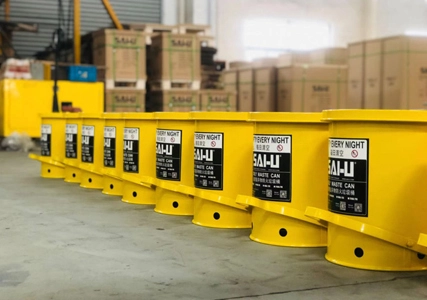English
Proper storage of flammable materials is critical to preventing accidents, fires, or explosions in both industrial and home environments. Whether managing chemicals, fuels, or other hazardous substances, following strict safety protocols ensures the safety of people, property, and the environment. This guide outlines key safety measures, best practices, and regulatory requirements to help you securely store flammable materials while maintaining compliance with industry standards.
Improper handling and storage of flammable liquids and gases can lead to devastating outcomes, such as property damage, serious injuries, or even loss of life. Adhering to national and international safety standards significantly reduces these risks while ensuring compliance with workplace safety regulations. By implementing proper storage practices, businesses and individuals can protect their facilities, employees, and surroundings from the dangers associated with flammable materials, fostering a safer and more secure environment.
Flammable substances present multiple hazards if not stored correctly. These materials can ignite easily, leading to rapidly spreading fires that can cause extensive damage. Additionally, some flammable substances release toxic fumes, which can be harmful or even deadly if inhaled. Improper storage conditions, such as poor ventilation or proximity to heat sources, can also create the risk of explosions, posing significant threats to both people and infrastructure. Understanding these risks underscores the importance of following stringent storage guidelines to mitigate potential dangers.
To ensure the safe storage of flammable materials, it’s essential to follow industry-approved guidelines that prioritize safety and compliance. Always store flammable liquids in safety cans that are UL-listed or FM-approved, ensuring they are tightly sealed to prevent leaks. Avoid using plastic containers unless they are specifically designed for flammable substances to reduce the risk of container failure. Proper ventilation is critical to prevent the accumulation of flammable vapors, which can create explosive atmospheres in confined spaces; installing effective ventilation systems helps disperse these fumes safely. Keep flammable materials at a safe distance from ignition sources, such as heat, sparks, or electrical equipment, and enforce a strict “No Smoking” policy in storage areas. Maintaining a minimum distance of 3-5 feet from electrical panels or machinery further reduces risks.
Store flammables in dedicated cabinets or rooms equipped with self-closing doors that meet OSHA and NFPA standards, ensuring that storage quantities do not exceed regulatory limits. Clear labeling using GHS-compliant labels and maintaining an updated inventory of stored chemicals help prevent confusion and ensure safe handling. Additionally, segregate incompatible substances to avoid dangerous chemical reactions. Emergency preparedness is also vital—keep Class B fire extinguishers nearby, train personnel on spill response and fire safety procedures, and install smoke detectors and fire suppression systems in storage areas to enhance safety measures.
Compliance with established safety standards is non-negotiable when storing flammable materials. OSHA’s 29 CFR 1910.106 provides comprehensive guidelines for the safe storage of flammable liquids, while NFPA 30, the Flammable and Combustible Liquids Code, outlines specific requirements for storage conditions and cabinet design. For transportation, DOT regulations govern the handling of hazardous materials to ensure safety during transit. Common violations to avoid include incorrect labeling of containers, exceeding storage quantity limits, inadequate ventilation, and insufficient fire protection measures. By adhering to these regulations and regularly reviewing compliance requirements, you can maintain a safe and legally compliant storage environment.
Safely storing flammable materials is both a legal obligation and a critical measure for protecting lives and property. By using certified storage containers, maintaining proper ventilation, adhering to safe distance protocols, storing materials in compliant cabinets, and following OSHA, NFPA, and local regulations, you can significantly reduce the risks associated with flammable substances. Training employees or household members on proper handling procedures further enhances safety. Staying proactive and informed ensures that your storage practices not only meet industry standards but also create a safer environment for everyone.
